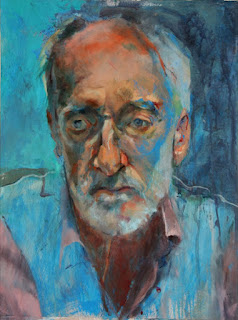Here's a portrait of Graham lit from above. I like the drama of the downlight and how it reveals the bumps and hollows that make up his particular face. I try my best to do less and less, to observe and select just those parts that 'make' the person.
The inspirational 20th century English painter, Walter Sickert said 'don't fill up gaps for the sake of filling up'. Too often, we paint the life out of something.
Sickert also said, if you have the patience to 'put free loose coat on free loose coat....one day the touches seem to take - the deaf canvas listens, and you have done something''
 ,
,This to me is good advice, it encourages us to keep a lively and creative approach, to allow the painting to 'paint itself'.
Working in layers I usually start with an under painting of acrylic, then I build up the image gradually, finding the face, mapping it out. To do this I need to be quiet and attentive, to really observe.
I am fascinated by edges; the place where one part stops and another begins. Here, the shape of Graham's right ear is defined by the thick turquoise paint of the background that is painted up to the edge of it. Then a thin broken line describes another edge where the shoulder meets the space around it.
One of the benefits of painting a loose layer of acrylic underneath is that it unifies the painting and allows for more freedom in the succeeding layers.
This is another painting of Graham, seen from the side. Although in reality the background was all the same tone, I deliberately painted a brighter turquoise below the chin so that it would outline its shape more clearly, and emphasise the fact that the skin under the chin is in shadow and set back. The forehead and tip of the nose, in contrast, are lighter than the background colour that edges them, so they become more prominent.
The physical application of paint is significant. In my opinion, variety is key, thickly applied swatches of paint sit alongside, and float above, the more transparent layers. I used rags and large brushes to apply thin paint, on his blanket for example, while the thicker paint was mostly put on with a piece of card.
I think, thick, opaque paint is best reserved for areas in the light that we want to 'bring out' and thinner paint, in general, works better in the shadows. Rembrandt painted the light falling on the skin so thickly it was said that you could pick his portraits up by the nose!
This blog is dedicated to Damian Callan, without who's help I would have given up ages ago.
http://www.damiancallan.co.uk/


This is a lovely portrait, Aine, esp the first one of Graham. And I like your explanation of how you got there. Really interesting.
ReplyDeleteI agree. Love this.
ReplyDeleteThank you! so good to get a comment at last...and then 2!! By the way, we will be drawing Graham on Monday 18th March at the Roslin British Legion, life drawing drop in from 12 to 3. Please email if you want more info aine@ainedivinepaintings.co.uk
DeleteBeautiful, Aine, would love to paint and draw with you in Texas
ReplyDelete